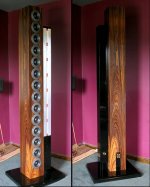After reading most old threads about diy ribbons I am planning to give it a try myself. I will first try 2" dipole tweeters with alu-foil, aiming at a response above 4KHz. Now, I have found very interesting magnets @ http://www.neotexx.com/index.htm?[url]http://www.neotexx.com/xaranshop_55_2.htm[/url]
(look for item # MQ-002500-52 ). I think a stack of 2x2/side (or perhaps 3X2 to achive a longer length, for I read the field is not very homegeneous at the ends) would give quite a strong field in the gap.
I would appreciate any comments.
(look for item # MQ-002500-52 ). I think a stack of 2x2/side (or perhaps 3X2 to achive a longer length, for I read the field is not very homegeneous at the ends) would give quite a strong field in the gap.
I would appreciate any comments.
No comments?
I have been playing around with Femm designing a motor for the ribbons. The most constant field I have gotten varies 0,147% from the resting position to +/- 1.5 mm (which I think is enoung displacemet or the freq. intended). What maxiamal variation of the field should I be aming at? What about variation thoughout the gap (fom magnet to magnet)?
I have been playing around with Femm designing a motor for the ribbons. The most constant field I have gotten varies 0,147% from the resting position to +/- 1.5 mm (which I think is enoung displacemet or the freq. intended). What maxiamal variation of the field should I be aming at? What about variation thoughout the gap (fom magnet to magnet)?
Those look like good magnets. Depending on the efficiency you want, I would think a single line of magnets on either side of the ribbon will give you a pretty good magnetic field in the gap. The 10mm width should be wide enough since ribbons move very little, probably a lot less than 1.5mm peak to peak, especially if you are only using it above 4k.
The 10mm thickness is also good and should give you something like .5 - .6 tesla across a 12.5 mm gap. You could probably get an extra 3db of output by doubling op on magnets to give you 20mm thickness but you shoul think about what mid/woof you will be using. It would be a shame to spend all the extra money for the extra magnets only to find you need to pad down your tweeter because it's too effeicient!
Best Regards,
Denis
My Ribbons Site
The 10mm thickness is also good and should give you something like .5 - .6 tesla across a 12.5 mm gap. You could probably get an extra 3db of output by doubling op on magnets to give you 20mm thickness but you shoul think about what mid/woof you will be using. It would be a shame to spend all the extra money for the extra magnets only to find you need to pad down your tweeter because it's too effeicient!
Best Regards,
Denis
My Ribbons Site
Attachments
Hi Dennis,
Thank you very much for your reply. I had visited your website, it it the best resource of information I have found other than the threads in this forum.
As I mentioned I have been playing with FEMM to model a nice motor and I came up with a desing that gives arond 0.52T with N40 magnets (which are the strongest in the library). The magnets have a curved profile on the four sides (I was inspired on a picture from a patent posted somewhere here) to achive a more uniform field strength horizontally and with steel on both sides of each magnet. The steel piece on the gap side is flat on the gap side. Do you know how the field variation correlates with distortion? What variation do you have perpendicular to the gap?
The next step is to design a waveguide or horn that aproximately matches the horizontal dispersion at the crossover point to the midrange. I will be using a JBL 2123H which has a 101dB sensitivity. I assume that the profile at the transition between gap and waveguide is of great importance and I wonder if the gap itself should be profiled to give a smooth transition to the waveguide.
Thanks again for your reply.
Sebastian
Thank you very much for your reply. I had visited your website, it it the best resource of information I have found other than the threads in this forum.
As I mentioned I have been playing with FEMM to model a nice motor and I came up with a desing that gives arond 0.52T with N40 magnets (which are the strongest in the library). The magnets have a curved profile on the four sides (I was inspired on a picture from a patent posted somewhere here) to achive a more uniform field strength horizontally and with steel on both sides of each magnet. The steel piece on the gap side is flat on the gap side. Do you know how the field variation correlates with distortion? What variation do you have perpendicular to the gap?
The next step is to design a waveguide or horn that aproximately matches the horizontal dispersion at the crossover point to the midrange. I will be using a JBL 2123H which has a 101dB sensitivity. I assume that the profile at the transition between gap and waveguide is of great importance and I wonder if the gap itself should be profiled to give a smooth transition to the waveguide.
Thanks again for your reply.
Sebastian
Here is the link to the post from Linesource where you can see a pic of the curved motor
http://www.diyaudio.com/forums/showthread.php?postid=1021968#post1021968
http://www.diyaudio.com/forums/showthread.php?postid=1021968#post1021968
- Status
- Not open for further replies.
